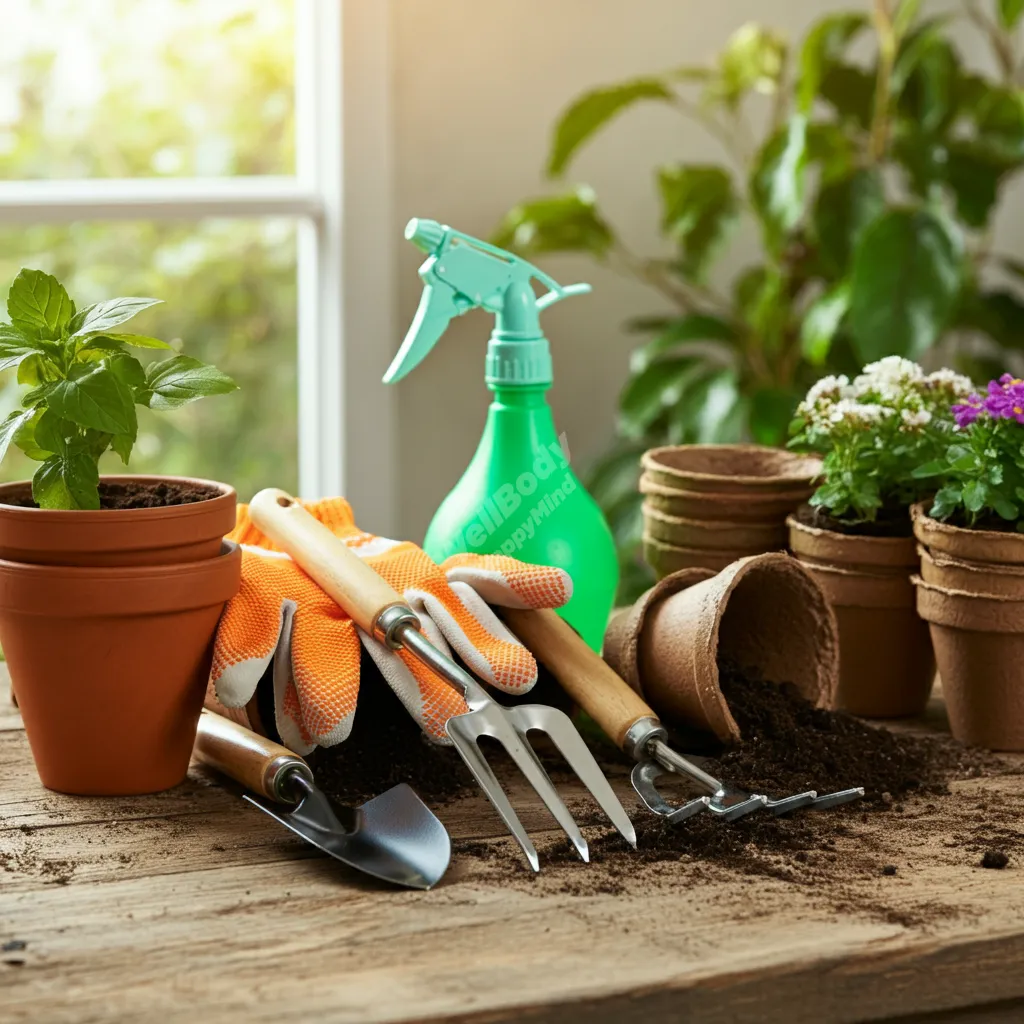Home Gardening: Boost Your Health While Growing Fresh Food

Have you ever considered that the secret to better health might be growing right in your backyard? Imagine a hobby that not only fills your plate with nutritious food but also strengthens your body and mind. Welcome to the world of home gardening!
Home gardening is more than just a pastime; it’s a powerful tool for improving both physical and mental well-being. This article will explore the surprising ways that tending to your garden can lead to a healthier, happier you. Whether you have a sprawling backyard or just a few pots on a balcony, you’re about to discover how home gardening health benefits can transform your life.
The Physical Benefits of Home Gardening
Cardiovascular Health: Cultivating a Strong Heart

Did you know that gardening can be as effective as a gym workout for your heart? When you dig, plant, and weed, you’re engaging in moderate-intensity cardiovascular exercise. This type of activity is crucial for maintaining a healthy heart and reducing the risk of heart disease.
Here’s a look at how many calories you can burn during various gardening tasks:
- Weeding: 200-400 calories per hour
- Mowing the lawn: 250-350 calories per hour
- Digging and shoveling: 400-600 calories per hour
- Raking leaves: 350-450 calories per hour
By regularly engaging in these activities, you’re not just growing plants – you’re cultivating a stronger, healthier heart.
Strength Training: Nature’s Gym

Forget about expensive gym memberships! Gardening for physical fitness is a natural way to build strength and tone muscles. Many gardening activities mimic the exercises you’d do in a gym, but in a more enjoyable and productive setting.
Here are some gardening tasks that double as strength training exercises:
- Lifting and carrying bags of soil or mulch (works arms, shoulders, and legs)
- Digging holes for planting (engages core, arms, and legs)
- Pushing a wheelbarrow (strengthens arms, shoulders, and back)
- Pruning trees and shrubs (tones arms and improves grip strength)
These activities help build functional strength – the kind you use in everyday life. Plus, you get the added benefit of a beautiful garden!
Flexibility and Balance: Bending Towards Better Health
As you reach for weeds or stretch to prune a tree, you’re improving your flexibility and balance without even realizing it. These gentle movements can be especially beneficial for seniors, helping to maintain mobility and reduce the risk of falls.
Gardening encourages a wide range of motion in your joints and muscles. Activities like planting seedlings, harvesting vegetables, and raking leaves require bending, stretching, and twisting. Over time, this can lead to improved flexibility and better overall body coordination.
Mental Health Benefits of Gardening
Stress Reduction: Finding Peace in the Soil

In our fast-paced world, stress has become a constant companion for many. But there’s good news: gardening can be a powerful antidote to stress. Research has shown that gardening can significantly lower cortisol levels – the hormone associated with stress.
One fascinating aspect of gardening’s stress-reducing properties is the concept of “earthing” or “grounding.” This involves direct physical contact with the earth, such as walking barefoot on grass or soil. Some studies suggest that this connection with the earth can have a calming effect on our nervous system, potentially reducing inflammation and improving sleep quality.
Improved Mood and Self-esteem: Harvesting Happiness
There’s something incredibly satisfying about nurturing a plant from seed to harvest. This sense of accomplishment can do wonders for your mood and self-esteem. As you watch your garden grow and flourish under your care, you’re also cultivating a sense of pride and self-worth.
Spending time in nature, even if it’s just in your backyard garden, has been linked to reduced symptoms of depression and anxiety. The combination of physical activity, exposure to nature, and the reward of growing your own food creates a powerful cocktail for improved mental health.
Moreover, gardening provides a sense of purpose and connection to the natural world. In a time when many of us feel disconnected from nature, tending to a garden can help us reconnect with the earth and find meaning in the simple act of nurturing life.
Nutritional Benefits of Home-Grown Produce
Fresher, More Nutritious Food: From Garden to Table

One of the most significant home gardening health benefits is the access to incredibly fresh, nutrient-rich produce. When you grow your own fruits and vegetables, you can harvest them at their peak ripeness, ensuring maximum nutritional value.
Store-bought produce often travels long distances and may sit on shelves for days, losing nutrients along the way. In contrast, home-grown produce can be consumed within minutes of harvesting, preserving its nutritional integrity.
Let’s compare the nutrient content of store-bought vs. home-grown vegetables:
| Vegetable | Nutrient | Store-Bought | Home-Grown | Difference |
|---|---|---|---|---|
| Spinach | Vitamin C | 28 mg/100g | 35 mg/100g | +25% |
| Tomatoes | Lycopene | 2.7 mg/100g | 3.5 mg/100g | +30% |
| Broccoli | Vitamin A | 623 IU/100g | 780 IU/100g | +25% |
As you can see, home-grown vegetables often contain significantly higher levels of essential nutrients, contributing to better overall health.
Encouraging Healthier Eating Habits: Grow Your Way to Better Nutrition
When you invest time and effort into growing your own food, you’re more likely to incorporate it into your meals. This can lead to a natural shift towards healthier eating habits. After all, who wouldn’t want to enjoy the fruits (and vegetables) of their labor?
Here are some tips for incorporating home-grown produce into your meals:
- Start your day with a smoothie using fresh berries from your garden
- Create colorful salads featuring a variety of home-grown leafy greens and vegetables
- Experiment with homemade sauces and salsas using your garden-fresh tomatoes and herbs
- Roast a medley of home-grown root vegetables for a hearty side dish
- Infuse water with mint or cucumber from your garden for a refreshing drink
By having fresh, nutritious produce readily available, you’re more likely to choose these healthier options over processed foods, contributing to better overall nutrition and health.
Getting Started with Home Gardening
Choosing the Right Plants for Your Space: Big or Small, There’s Room for All

Whether you have a spacious backyard or a tiny apartment balcony, there’s a gardening solution for you. The key is to choose plants that suit your available space and sunlight conditions.
For small spaces and balconies:
- Herbs (basil, mint, cilantro)
- Cherry tomatoes
- Leafy greens (lettuce, spinach)
- Peppers
- Microgreens
For larger yards:
- Zucchini and squash
- Full-sized tomatoes
- Root vegetables (carrots, potatoes)
- Fruit trees
- Berry bushes
If you’re new to gardening, start with these easy-to-grow vegetables:
- Radishes
- Green beans
- Peas
- Cucumbers
- Swiss chard
Remember, start small and expand gradually. It’s better to have a few thriving plants than to be overwhelmed by a large, unmanageable garden.
Essential Tools and Equipment: Gearing Up for Success

To get started with home gardening, you don’t need a shed full of expensive equipment. Here are the basic tools every beginner gardener should have:
- Garden gloves
- Hand trowel
- Garden fork
- Watering can or hose
- Pruning shears
- Rake
- Wheelbarrow or garden cart (for larger gardens)
For those with physical limitations, consider ergonomic tools with padded handles and extended reaches. These can make gardening more comfortable and reduce strain on your body.
Creating a Sustainable Garden: Nurturing Nature
A sustainable garden works in harmony with nature, reducing the need for chemical interventions and conserving resources. Here are two key aspects of sustainable gardening:
- Composting: This is nature’s way of recycling. Start a compost bin with kitchen scraps and yard waste. Over time, this will break down into nutrient-rich soil for your garden, reducing the need for chemical fertilizers.
- Natural Pest Control: Instead of reaching for pesticides, try these eco-friendly methods:
- Companion planting (e.g., planting marigolds near vegetables to repel pests)
- Encouraging beneficial insects like ladybugs and praying mantises
- Using physical barriers like row covers or netting
- Making homemade pest sprays with ingredients like neem oil or garlic
By adopting these sustainable practices, you’re not just growing food – you’re nurturing a healthy ecosystem in your own backyard.
Incorporating Gardening into Your Fitness Routine
Gardening as a Low-Impact Exercise: Nature’s Gym Membership

One of the most overlooked aspects of gardening for physical fitness is its potential as a low-impact, full-body workout. Unlike high-intensity exercises that can be hard on your joints, gardening provides a gentler way to stay active and healthy.
Gardening activities engage multiple muscle groups simultaneously, offering a balanced workout that can improve strength, flexibility, and endurance. For those who find traditional exercise routines boring or challenging, gardening can be an enjoyable and productive alternative.
Here’s a sample weekly gardening fitness plan:
| Day | Activity | Duration | Muscles Worked |
|---|---|---|---|
| Monday | Digging and planting | 45 mins | Arms, back, legs, core |
| Tuesday | Weeding and mulching | 30 mins | Arms, shoulders, core |
| Wednesday | Pruning and harvesting | 40 mins | Arms, shoulders, grip strength |
| Thursday | Mowing and raking | 60 mins | Full body, cardio |
| Friday | Watering and light maintenance | 30 mins | Arms, walking |
| Saturday | Heavy lifting (soil, rocks, etc.) | 45 mins | Full body strength |
| Sunday | Garden planning and rest | – | Mental exercise |
Remember, the key is consistency. Even 15-30 minutes of gardening daily can contribute significantly to your overall fitness and health.
Proper Techniques to Prevent Injury: Safety First in the Garden
While gardening is generally safe, improper techniques can lead to strain or injury. Here are some tips to ensure you’re gardening safely and effectively:
- Use proper posture: Keep your back straight and bend at the knees when lifting.
- Alternate tasks: Switch between activities to avoid repetitive strain.
- Take breaks: Listen to your body and rest when needed.
- Stay hydrated: Drink plenty of water, especially on hot days.
- Use sun protection: Wear a hat, sunglasses, and sunscreen.
Before and after gardening, consider doing these stretches to prevent muscle soreness:
- Shoulder rolls
- Gentle back bends
- Hamstring stretches
- Wrist and finger stretches
- Neck rotations
By incorporating these practices, you can enjoy the health benefits of home gardening while minimizing the risk of injury.
Conclusion: Cultivating Health and Happiness

As we’ve explored throughout this article, home gardening offers a unique blend of physical activity, mental stimulation, and nutritional benefits. It’s not just a hobby – it’s a holistic approach to health and wellness that can transform your life in numerous ways.
From improving cardiovascular health and building strength to reducing stress and boosting mood, the benefits of gardening are far-reaching. Add to this the joy of growing your own nutritious food, and you have a powerful recipe for overall well-being.
Whether you have acres of land or just a few pots on a windowsill, there’s a gardening solution for everyone. By starting small, choosing the right plants, and incorporating sustainable practices, you can create a thriving garden that nourishes both body and soul.
So why not take the first step today? Grab a pot, some soil, and a few seeds, and start your journey towards a healthier, happier you. Remember, every expert gardener was once a beginner. The most important thing is to start and enjoy the process.
As you nurture your garden, you’ll find that you’re not just growing plants – you’re growing a stronger, healthier version of yourself. Happy gardening!



